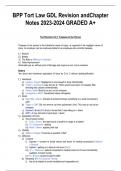Exam (elaborations)
BPP Tort Law GDL Revision andChapter Notes GRADED A+
- Course
- Institution
BPP Tort Law GDL Revision andChapter Notes GRADED A+ Tort Revision Ch 2: Trespass to the Person Trespass to the person is the intentional cause of injury, as opposed to the negligent cause of injury. An employer can be vicariously liable for an employee who commits trespass. 1) Assault 2) ...
[Show more]



